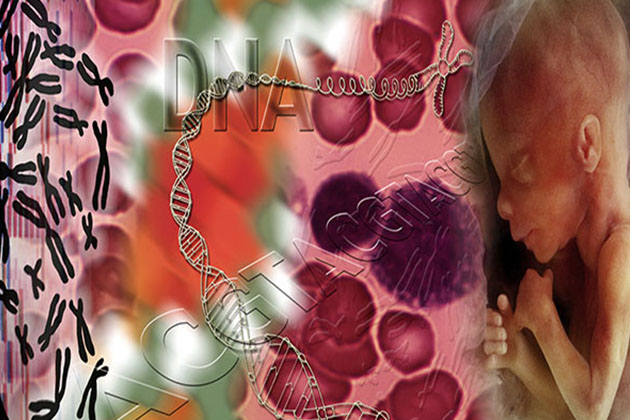Un estudio es prometedor para el tratamiento de enfermedades genéticas en un mamífero durante el desarrollo fetal en los primeros tres meses de embarazo.
A genéticas El trastorno es una condición o enfermedad causada por cambios anormales o mutaciones en el ADN de una persona en el gen. Nuestro ADN provides the required code for making proteins which then perform most of the functions in our body. Even if one section of our DNA gets altered in some way, the protein associated with it can no longer carry out its normal function. Depending upon where this change happens either it can have a little or no effect or it might alter the cells so much that it could then lead to a genéticas disorder or illness. Such changes are caused by errors in DNA replication (duplication) during growth, or environmental factors, lifestyle, smoking and exposure to radiation. Such disorders are passed on to the offspring and start to occur when the baby is developing in mother’s uterus and are therefore referred to as ‘birth defects’.
Birth defects can be minor or extremely severe and may affect appearance, function of an organ and some aspect of physical or mental development. Millions of children are born annually with serious genéticas conditions. These defects can be detected during pregnancy as they are evident within the first three months of pregnancy when the organs are still forming. A technique called amniocentesis is available for detecting genéticas abnormalities in the foetus by testing amniotic fluid extracted from the uterus. However, even with amniocentesis, treating them is not possible as no options are available to make any corrections before birth of the baby. Some of the defects are harmless and require no intervention but some others can be of serious nature and may require long-term treatment or even be fatal for the infant. Some defects can be corrected shortly after birth of the baby – example within a week’s time – but mostly it is too late for treatment.
Curación genéticas condition in an unborn baby
For the first time the revolutionary gene editing technique has been used to cure a ‘genéticas disorder’ in mice during foetal development in the uterus in a study by researchers at Carnegie Mellon University and Yale University. It is well established that during early development in the embryo (during first three months of a pregnancy) there are many stem cells (an undifferentiated cell type which can become any type of cell upon maturation) that are dividing at a fast rate. This is the pertinent time point where a genéticas mutation if corrected would reduce the impact of the mutation on embryo-to-foetal development. There are chances that a severe genéticas condition could even be cured and the baby is born without the unintended birth defects.
En este estudio publicado en Nature Communications researchers have used a peptide nucleic acid-based gene editing technique. This technique has been used before to treat beta thalassemia – a genéticas blood disorder in which haemoglobin (HB) produced in the blood is reduced considerably which then affects normal oxygen supply to various parts of the body leading to severe abnormal consequences. In this technique, unique synthetic molecules called peptide nucleic acids (PNAs) (made of a combination of synthetic protein backbone with DNA and RNA) were created. A nanoparticle was then used to transport these PNA molecules along with “healthy and normal” donor DNA to the location of a genéticas mutation. The complex of PNA and DNA identifies the designated mutation at a site, PNA molecule then binds and unzips the double helix of mutated or faulty DNA. Lastly, donor DNA binds with the mutated DNA and automates a mechanism to correct the DNA error. The main significance of this study is that it was done in a foetus, thus researchers had to use a method analogous to amniocentesis wherein they inserted the PNA complex into the amniotic sac (amniotic fluid) of pregnant mice whose foetuses were carrying the gen mutación que causa beta talasemia. Después de una inyección de PNA, se corrigió el 6 por ciento de las mutaciones. Estos ratones mostraron una mejora en los síntomas de la enfermedad, es decir, los niveles de hemoglobina estaban en un rango normal, lo que podría interpretarse como que los ratones se "curaron" de la enfermedad. También mostraron una mayor tasa de supervivencia. Esta inyección estaba en un rango muy limitado, pero los investigadores tienen la esperanza de que se puedan lograr tasas de éxito aún más altas si las inyecciones se realizaron varias veces.
El estudio es relevante porque no se observaron objetivos fuera de los objetivos y solo se corrigió el ADN deseado. Aunque las técnicas de edición de genes como CRISPR / Cas9 son más fáciles de usar con fines de investigación, sigue siendo controvertida porque corta el ADN y lleva a cabo errores fuera del sitio, ya que también dañan un ADN normal fuera del objetivo. Debido a esta limitación, no son ideales para diseñar terapias. Teniendo en cuenta este factor, el método que se muestra en el estudio actual solo se une al ADN objetivo y lo repara y muestra ningún error externo. Esta cualidad específica la hace ideal para la terapéutica. Un método de este tipo en su diseño actual también podría usarse para "curar" otras afecciones en el futuro.
***
{Puede leer el trabajo de investigación original haciendo clic en el enlace DOI que figura a continuación en la lista de fuentes citadas}
Fuentes)
Ricciardi AS y col. 2018. Entrega de nanopartículas en el útero para la edición del genoma específico del sitio. Nature Communications. https://doi.org/10.1038/s41467-018-04894-2
***






































